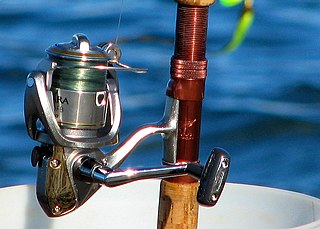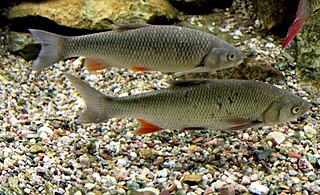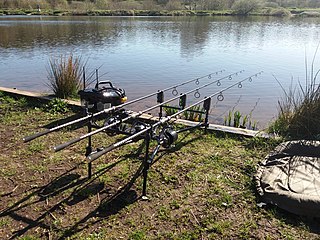Related Research Articles

Trolling is a method of fishing where one or more fishing lines, baited with lures or bait fish, are drawn through the water. This may be behind a moving boat, or by slowly winding the line in when fishing from a static position, or even sweeping the line from side-to-side, e.g. when fishing from a jetty. Trolling is used to catch pelagic fish such as salmon, mackerel and kingfish.

A fishing rod is a long, elastic rod used by fishermen to catch fish by manipulating a line ending in a hook. At its simplest form, a fishing rod is a straight stick or pole with a line attached to one end, but modern rods generally have the line stored on a reel mounted at the rod handle, which controls the line retrieval, as well as line-guiding swivels that reduce tangling. To better entice fish, bait or lures are dressed on the one or more hooks attached to the line, and a bite indicator is used, some of which might be incorporated as part of the rod itself.

A fishing reel is a cranking reel attached to a fishing rod used in winding and stowing fishing line.

A fishing line is a cord used or made for angling. Fishing lines generally resemble a long, thin string, and vary in material. Important attributes of a fishing line include length, material, weight, and thickness. Other factors relevant to certain fishing environments include breaking strength, knot strength, UV resistance, castability, limpness, stretch, abrasion resistance, and visibility. Most modern lines are made from nylon, braided polymers, or silk.

Squalius cephalus is a European species of freshwater fish in the carp family Cyprinidae. It frequents both slow and moderate rivers, as well as canals and still waters of various kinds. This species is referred to as the common chub, European chub, or simply chub.

Fly fishing is an angling method that uses a light-weight lure—called an artificial fly—to catch fish. The fly is cast using a fly rod, reel, and specialized weighted line. The light weight requires casting techniques significantly different from other forms of casting. The flies may resemble natural invertebrates, bait-fish, or other food organisms.

Angling is a method of fishing by means of a fish hook or "angle". The hook is attached to a fishing line, which is usually manipulated via a fishing rod, although rodless techniques such as handlining also exist. Modern fishing rods are usually fitted with a fishing reel that functions as a cranking device for storing, retrieving and releasing out the line, although Tenkara fishing and cane pole fishing are two rod-angling methods that do not use a reel. The hook itself can be additionally weighted with a tackle called a sinker, and is typically dressed with an appetizing bait to attract the fish, but sometimes an inedible fake bait known as a lure with multiple attached hooks is used in place of a single hook with bait. A bite indicator, such as a float or a quiver tip, is often used to relay underwater status of the hook to the surface.
Bottom fishing, also called legering in the United Kingdom, is fishing of the bottom of a deep body of water such as lake or ocean, targeting groundfish such as sucker fish, bream, catfish and crappie. It is contrasted with conventional angling in that no float is used with the fishing line.

Fishing tackle is the equipment used by anglers when fishing. Almost any equipment or gear used for fishing can be called fishing tackle. Some examples are hooks, lines, sinkers, floats, rods, reels, baits, lures, spears, nets, gaffs, traps, waders and tackle boxes.

In the British Isles, coarse fishing refers to angling for rough fish, which are fish species traditionally considered undesirable as a food or game fish. Freshwater game fish are all salmonids — most particularly salmon, trout and char — so generally coarse fish are freshwater fish that are not salmonids. There is disagreement over whether grayling should be classified as a game fish or a coarse fish.
Groundbait is a fishing bait that is either thrown or "balled" into the water in order to olfactorily attract more fish to a designated area for more efficient catching via angling, netting, trapping, or even spearing and shooting. Groundbaits are typically scattered separately from the hook and usually before even casting any rod or net, although in bottom fishing they can be deployed synchronously with hookbaits while contained inside a gradual-release device also attached to the fishing line known as a feeder.

A fishing float or bobber is an item of angling equipment. Usually attached to a fishing line, it can serve several purposes. Firstly, it can suspend the bait at a predetermined depth; secondly, due to its buoyancy, it can carry the baited hook to otherwise inaccessible areas of water by allowing the float to drift in the prevailing current; and thirdly, a float also serves as a visual bite indicator. Fishing with a float is sometimes called float fishing.

A bite indicator is a mechanical or electronic device which indicates to an angler that something is happening at the hook end of the fishing line.
Spin fishing is an angling technique where a spinning lure is used to entice the fish to bite. Spin fishing is used in both freshwater and marine environments. Spin fishing is distinguished between fly fishing and bait cast fishing by the type of rod and reel used. There are two types of reels used when spin fishing, the open faced reel and the closed faced reel. The spin fishing rod has no trigger attached to the base of the fishing rod. This is what differentiates the spin fishing rod from the bait casting fishing rod.

Fishing techniques are methods for catching fish. The term may also be applied to methods for catching other aquatic animals such as molluscs and edible marine invertebrates.
Fly fishing tackle comprises the fishing tackle or equipment typically used by fly anglers. Fly fishing tackle includes:
The following outline is provided as an overview of and topical guide to fishing:

Carp is a common name for various species of freshwater fish that are sought after by some recreational fishermen. Carp are native to Europe and Asia, and belong to the family Cyprinidae. They have been introduced, with mixed results, to various other locations around the world.
Kite fishing, a fishing technique. It involves a kite from which a drop line hangs, attached to a lure or bait. The kite is flown over the surface of a body of water, and the bait floats near the waterline until taken by a fish. The kite then drops immediately, signaling to the fisherman that the bait has been taken, and the fish can then be hauled in. Kites can provide boatless fishermen access to waters that would otherwise be available only to boats. Similarly, for boat owners, kites provide a way to fish in areas where it is not safe to navigate - such as shallows or coral reef.
A tip-up is a device used while ice fishing to suspend live or frozen bait at a set depth through a hole drilled in the ice with an auger, and detect when a fish strikes, without having to be in contact with this piece of gear. When a fish does take the bait, a flag "tips up" or the flag can "tip down" to signal the angler that a fish has taken the bait. Anglers can see the flag from a distance and can thus manage multiple holes at once, covering a larger area than with just an ice fishing rod.

